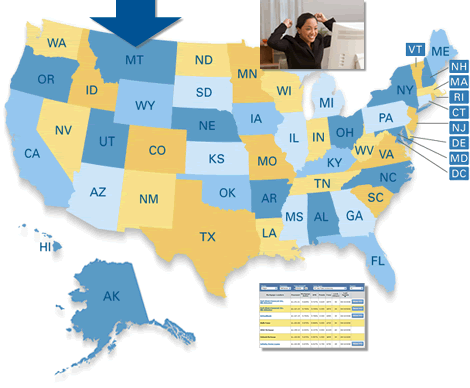Real Estate Market
Justice, voice for minority housing crisis
Minority Realtors converge on Capital as AIG settles $6.1 million
discrimination suit
by Broderick Perkins
Just as realty professionals descended on the nation's capital to heighten awareness about the housing crisis' disparate impact on minority communities, their cause was underscored by the Justice Department's largest ever settlement to compensate victims of lending discrimination.
The 2010 Multicultural Real Estate & Policy Conference "The Color of the Housing Recovery," convened in Washington, D.C. March 4-5 to introduce "Five-Point Plan: Creating A Sustainable Path to Minority Homeownership," an appeal to lawmakers to take actions that stabilize the market, expand consumer protections, preserve liquidity and especially stop the spiral of losses in minority communities.
The day members of the National Association of Hispanic Real Estate Professionals (NAHREP); the Asian Real Estate Association of America (AREAA); and the African American-led National Association of Real Estate Brokers (NAREB) arrived in Washington, a landmark federal court settlement in New York City was setting the tone for the conference.
Typical in such settlements, without acknowledging any wrongdoing, the now defunct AIG Federal Savings Bank and Wilmington Finance, Inc. settled with the U.S. Justice Department to pay $6.1 million to resolve allegations the wholesale lenders illegally allowed wholesale mortgage brokers to charge higher direct broker fees to 2,500 black borrowers.
Under the settlement, "United States of America v. AIG Federal Savings Bank," tried in the U.S. District Court, District of Delaware (Wilmington), the banks must deposit $6.1 million into an escrow fund to pay borrowers overcharged for up-front fees to the brokers who secured their real estate loans. The banks also must contribute at least $1 million to financial education programs for black consumers.
AIG Federal Savings and Wilmington Finance were subsidiaries of American International Group, Inc., yes, that AIG, once the world's largest insurer, which received a $182.3 billion bailout package that included aid in November 2008 to retire derivatives tied to U.S. home loans.
Organized crime?
The Justice Department's action was an outgrowth of the Financial Fraud Enforcement Task Force, which President Barack Obama appointed to scrutinize practices that led to the financial crisis.
As the housing market peaked, predatory lending and mortgage fraud wasn't attached to known organized crime circles, according to the Federal Bureau, but it came with the hallmarks of organized crime exhibiting collusion, conspiracy and insider cooperation.
The Center for Responsible Lending, a consumer-advocacy group, said that according to government data from 2002 to 2007, half of African-American home mortgages were subprime, compared with about 20 percent for whites.
"Communities of color remain at great risk. We must take common sense actions that stop the spiral of losses, keep homeowners in place and prevent our neighborhoods from becoming renter communities," said NAHREP Chairman Alex Chaparro.
Five Point PlanThe three trade associations, which represent the most impacted communities, call for support of a five-point plan that:
• Expands the scope of Community Reinvestment Act (CRA) functions to include loan servicing.
• Mandates pre-purchase, face-to-face homebuyer education and household budget management training.
• Provides principal forgiveness for homeowners who are underwater on their mortgage and have more than 10 percent negative equity.
• Advocates the role of the GSEs (Government Sponsored Enterprises) and FHA (Federal Housing Administration) to expand the flow of stable capital to the mortgage market.
• Promotes the role of a consumer protection agency that puts consumer interests first and is empowered to implement robust reforms that align industry practices with values that serve the common good.
Leaders of the three conference groups say current government programs to address the housing crisis have had limited impact, especially in minority neighborhoods where the incidence of expensive mortgages and higher unemployment is greater.
At the peak of the housing expansion, African Americans and Latinos held high cost mortgages at two to nine times the frequency of whites in some foreclosure regions.
According to a report from the Federal Reserve, African American borrowers were 1.8 times as likely as white borrowers to be in foreclosure and Latino and Asian borrowers were 1.4 and 1.3 times, respectively, to be in foreclosure.
"The collaborative effort of African American, Hispanic and Asian American real estate professionals signals a broad call to action. Our respective communities have experienced previously unimaginable losses since the onset of the mortgage loan debacle and the subsequent far-reaching economic crisis," said Vincent Wimbish, President and CEO of NAREB.
"We firmly believe that the five-point plan offers a solutions-based approach to making homeownership not only sustainable but once again desirable for communities of color as well as for all Americans," Wimbish added.
Refinance at Today's Low Rates!
Follow the link to continue reading the related articles
Latest Housing Figures Suggest Another Dip
Government Ramping Up New Short Sale Program
Housing Related Tax Incentives: Are They Really Such a Good Idea?
Fannie Mae & Jumbo Mortgage Rates
Just One Click! = Current Rate Chart


